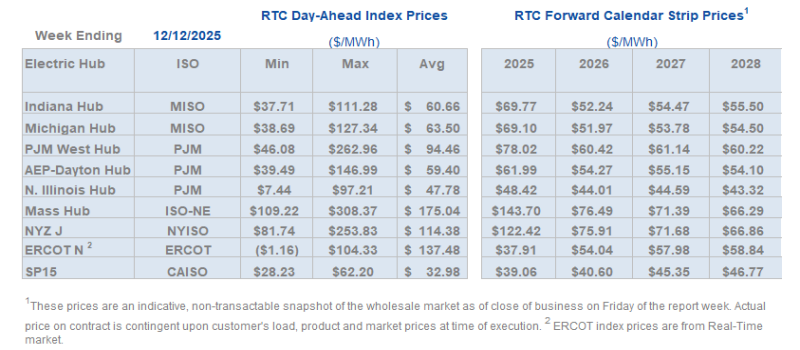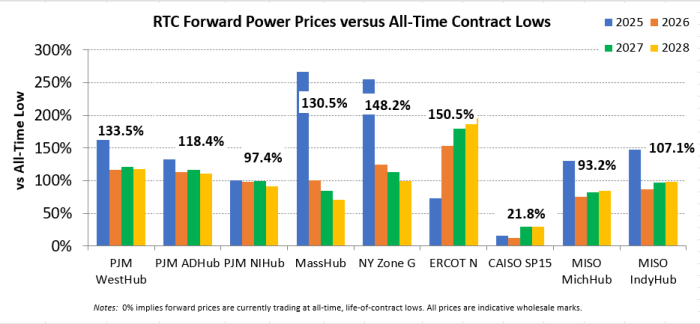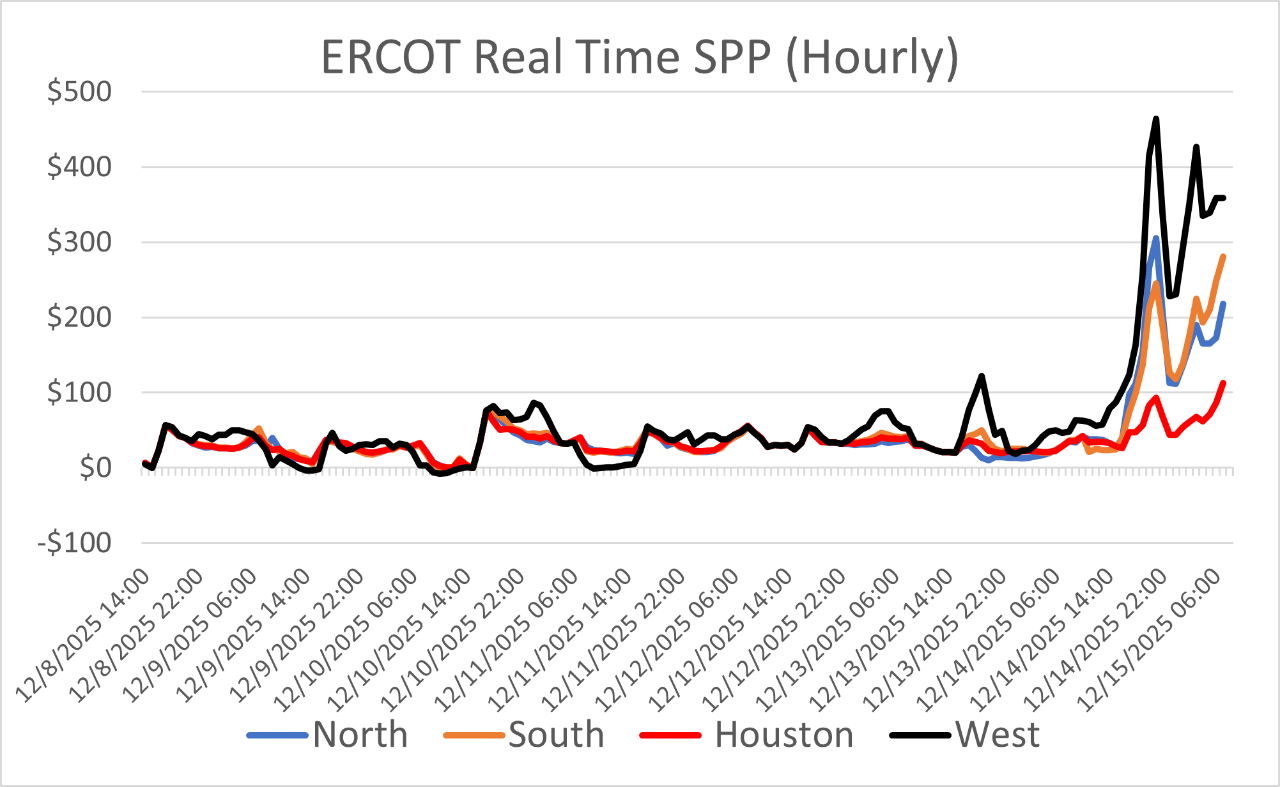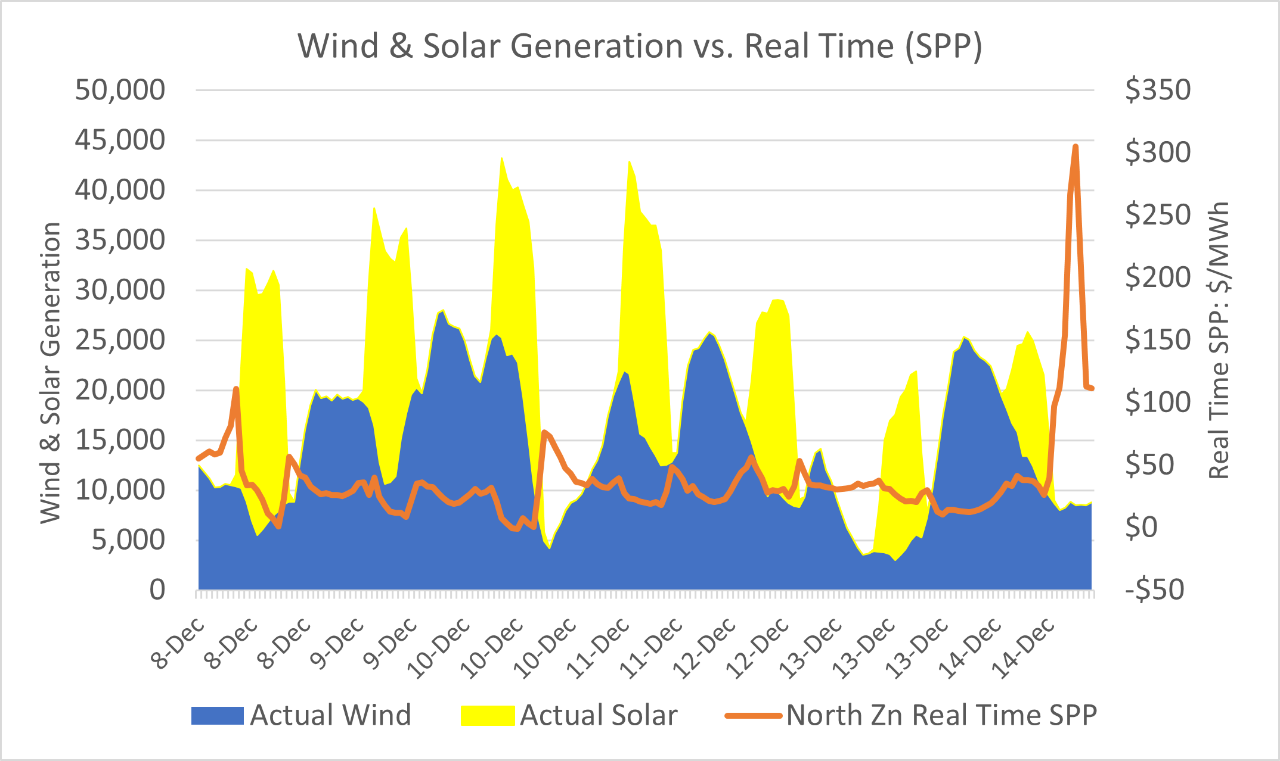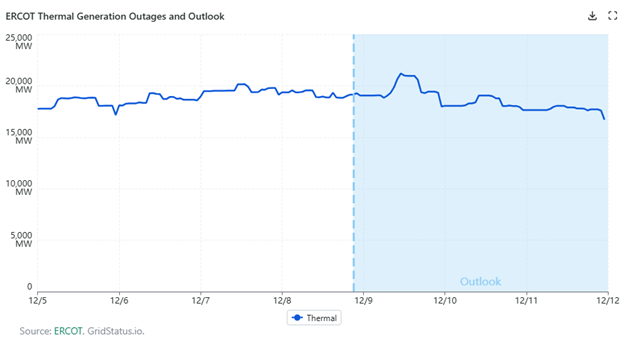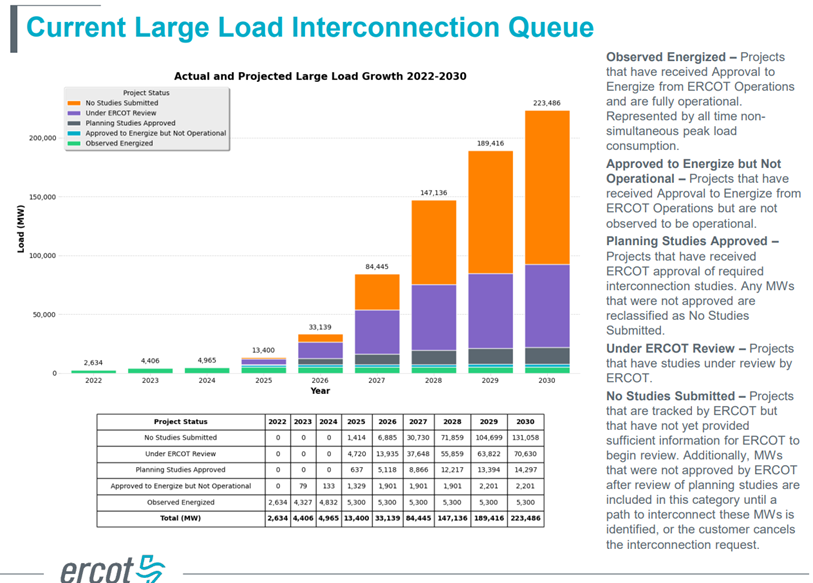NOTE: We will not be sending the Energy Market Update for the weeks of December 22 and December 29. We wish you and your families a safe and happy holiday season.
Weekly Energy Industry Summary
Commodity Fundamentals
Week of December 15, 2025
By The Numbers:
- Prompt month NYMEX natural gas settled at $4.01/MMbtu, down $.10 on Monday, December 15.
- Prompt month NYMEX natural gas settled at $4.92/MMbtu on Monday, December 8.
- Prompt month NYMEX crude oil settled at $56.82/bbl., down $0.62 on Monday, December 15.
- Prompt month NYMEX crude oil settled at $58.88/bbl., down $1.20 on Monday, December 8.
Natural Gas Fundamentals - Neutral/Bearish
- A mid-month warm up drives natural gas prices down.
- The cold air is retreating from the southern and middle tier of the country, but cold air remains in place in Canada.
- Constellation's weather desk is forecasting a return of cold air in January and is holding its winter population-weighted heating degree days in place from last week.
- Surging production through the fourth quarter and in the month of December is keeping more than a lid on the gas market thus far.
- Production in December averaged 109.3 Bcf per day, versus 104.1 for the same period last year.
- Power-generation demand in December averaged 37.9 Bcf per day versus 35.1 for the same period last year.
- Residential/commercial consumption in December averaged 47.3 Bcf per day versus 40.7 for the same period last year.
- Industrial consumption in December averaged 26.4 Bcf per day versus 25.7 for the same period last year.
- LNG exports averaged 18.6 Bcf per day in December versus 13.9 for the same period last year.
- Exports to Mexico averaged 5.6 Bcf per day in December versus 6.1 for the same period last year.
- Production is up, storage is adequate, demand is strong - the wild card is weather - is winter over? Or has it just gotten started?

Crude Oil - Bearish
- NYMEX (WTI) prompt-month crude settled at $56.82/bbl., on Monday, December 15 down $.62.
- Global supplies of crude oil are abundant. WTI and Brent both broke key technical price support over the past 24 hours.
- Various sources point to $55/bbl., as a price point of inflection -- break that and a near-term move to $50 is in the cards.
- Crude is a buyer's market as 2025 expires.
- Crude oil at or below $50 is bullish of natural gas, all other things being equal.

Economy - Neutral
- Nonfarm payrolls growth totaled a seasonally adjusted 64,000 for the month of November, up from a sharp decline reported in October of 105,000 jobs.
- The unemployment rate rose to 4.6 percent.
- Healthcare accounted for 70% of the net increase to jobs.
- Precious metals continue to climb with spot gold breaching $4,300 per ounce.
- The pace of U.S. home-price-increases is slowing, The Wall Street Journal reports.
- The Federal Reserve lowered rates a quarter point.

Weather - Bearish
- A general warm-up in the middle tier and southern tier is underway dominating the 11-15 day outlook.
- Cold air remains in place in Canada and snow cover is deeper than the last ten years for mid-December.
- Constellation's weather desk is calling for a return of cold air in January.
- Near term, weather is Bearish of natural gas pricing action.
- A cold January would provide support to pricing action with upside potential.

Weekly Natural Gas Report:
- Inventories of natural gas in underground storage for the week ending December 5 are 3,746 Bcf; a withdrawal of 177 Bcf was reported for the week ending December 5.
- Gas inventories are 103 Bcf above the five-year average and 28 Bcf less than the same time last year.




Weekly Power Report:
Mid-Atlantic Electric Summary
- The Mid-Atlantic Region’s forward power prices fell significantly in that past week, along with natural gas prices, as short-term weather forecasts went from extreme cold to milder for much of the US. January natural gas futures posted its biggest loss in that past three years dropping 22% on Friday and recently reached a six-week low, after surging to recent highs over $5.00/MMBtu on a bit of over-exuberance in the market. Though colder risks and variability remain for the northern tier of the US due to persistently cold temperatures in Canada, the West and South are expected to be warmer than normal over the next couple of weeks. Forward power price averages for the 2026-2030 terms were -6% lower over the past week, with a -10% decrease for the 2026 term, while the back of the curve (2028-2030) saw a -5% drop. The current month-to-date, day-ahead settlement price average in West Hub is $88.57/MWh, which is 65% higher than the prior month of November and 133% higher than the prior year.
- FERC Accepts PJM’s Proposal to Recover Costs of DOE 202(c) Orders - On 12/5, FERC accepted PJM’s proposal to establish a regionwide cost allocation methodology through which PJM will recover the costs by resources ordered to remain in operation by the DOE under section 202(c) of the Federal Power Act where (1) such orders direct the continued operations for resource adequacy for the entire PJM Region and (2) the owner of such resource and PJM agree to a rate for compensation that is based on the existing Deactivation Avoidable Cost Credit. FERC concluded that allocating costs to all PJM load-serving entities across the PJM region based on their share of unforced capacity obligations is consistent with cost causation principles and rejected arguments for further analysis or limited allocation to certain entities. With this order, PJM will have a defined and automatic mechanism for allocating costs incurred by resources that are required to remain in operation as the result of a DOE order under section 202(c).
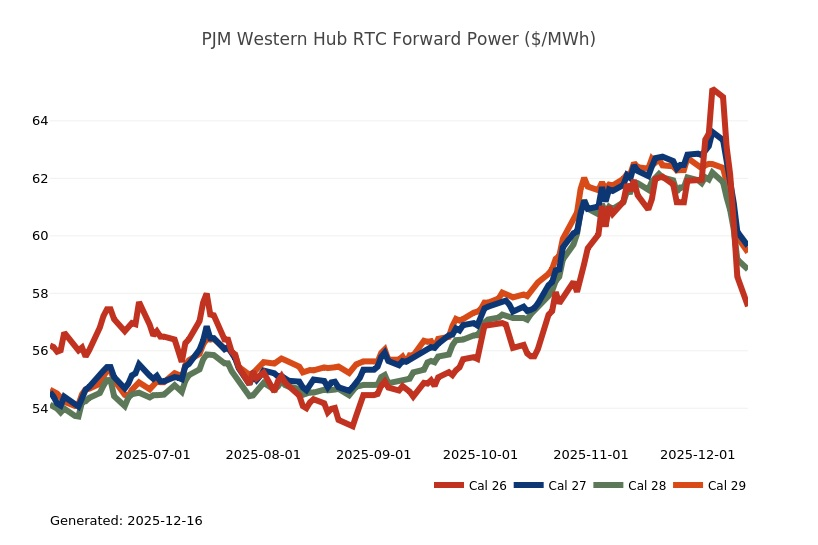



Great Lakes Electric Summary
- The Great Lakes Region’s forward power prices fell significantly in that past week, along with natural gas prices, as short-term weather forecasts went from extreme cold to milder for much of the US. January natural gas futures posted its biggest loss in that past three years dropping 22% on Friday and recently reached a six-week low, after surging to recent highs over $5.00/MMBtu on a bit of over-exuberance in the market. Though colder risks and variability remain for the northern tier of the US due to persistently cold temperatures in Canada, the West and South are expected to be warmer than normal over the next couple of weeks. Forward power price averages, for the 2026-2030 terms, were -6% lower over the past week with a -10% decrease for the 2026 term and a -4% drop on the back of the curve for the 2028-2030 terms. The month-to-date, day-ahead settlement price average in COMED is $51.56/MWh or 40% higher than last month, while the month-to-date average price in AdHub is $61.14/MWh or 29% higher than November. In Michigan those same month-to-date prices are averaging $62.29/MWh or 49% higher vs. the prior month, while the settlement prices in Ameren are averaging $56.54/MWh, which is 50% higher than last month.
- FERC Accepts PJM’s Proposal to Recover Costs of DOE 202(c) Orders - On 12/5, FERC accepted PJM’s proposal to establish a regionwide cost allocation methodology through which PJM will recover the costs by resources ordered to remain in operation by the DOE under section 202(c) of the Federal Power Act where (1) such orders direct the continued operations for resource adequacy for the entire PJM Region and (2) the owner of such resource and PJM agree to a rate for compensation that is based on the existing Deactivation Avoidable Cost Credit. FERC concluded that allocating costs to all PJM load-serving entities across the PJM region based on their share of unforced capacity obligations is consistent with cost causation principles and rejected arguments for further analysis or limited allocation to certain entities. With this order, PJM will have a defined and automatic mechanism for allocating costs incurred by resources that are required to remain in operation as the result of a DOE order under section 202(c).
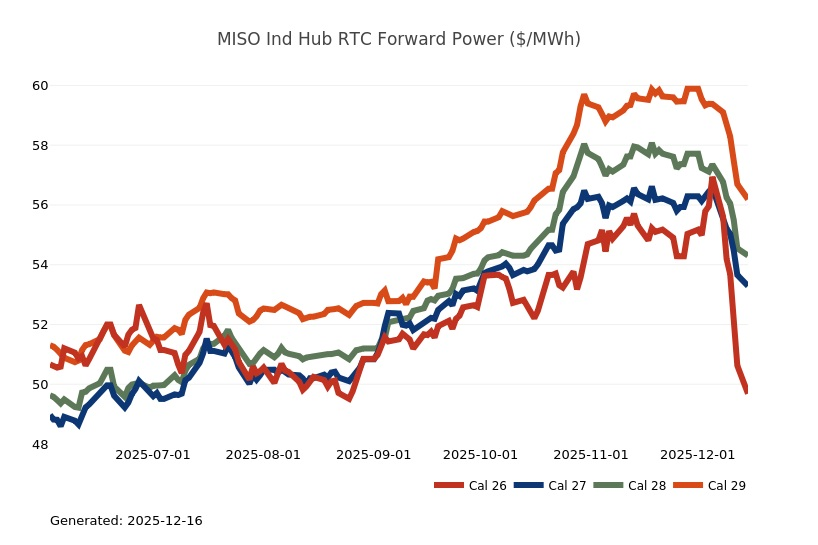
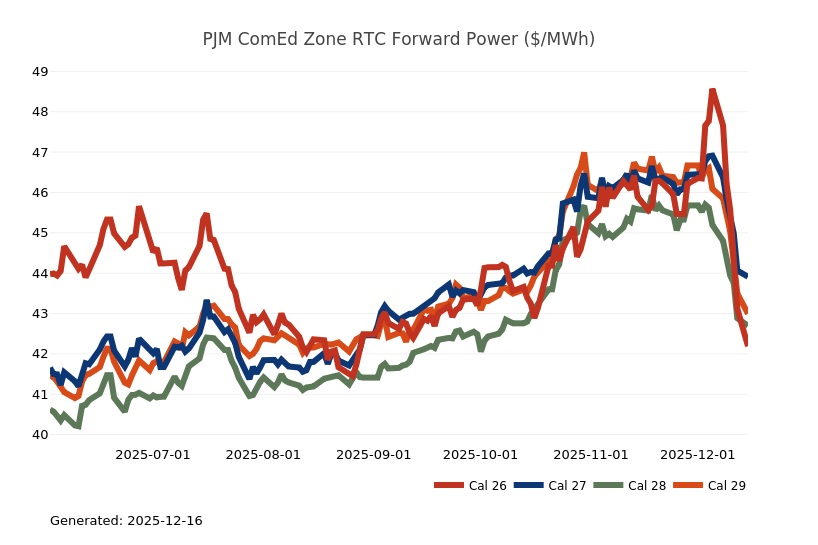

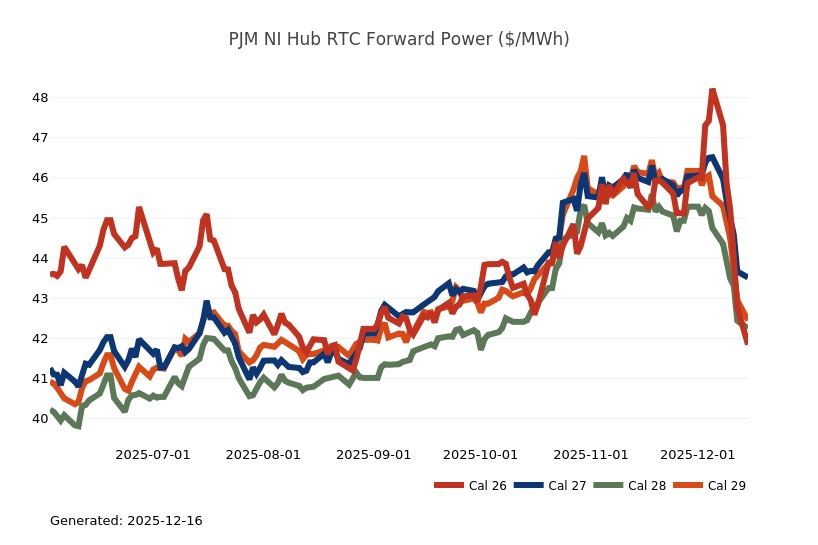
Northeast Energy Summary
- On December 4, the NEPOOL Participants Committee (PC) overwhelmingly approved ISO-NE’s Capacity Auction Reforms – Prompt/Deactivation package (CAR-PD). CAR-PD includes tariff related changes to the capacity auction to move from a three-year forward market to a prompt market and decouples retirement decisions from the capacity auction, balancing reliability considerations with efficiency under the new deactivation notification process. For the past 18 years, the ISO has administered the Forward Capacity Market (FCM) through annual auctions that secure resource commitments more than three years in advance. After extensive stakeholder discussions and broad support, FERC approved the ISO’s proposal to delay Forward Capacity Auction 19 (FCA 19) to allow time for developing a prompt and seasonal market with accreditation reforms. The CAR-PD proposal transitions the FCM to prompt, leveraging more current and accurate information to deliver stronger price signals. This approach ensures the use of the latest load forecasts and provides participants with more representative asset values. Additionally, requiring resources to be commercial before participating will mitigate risks of “phantom entry,” where capacity is sold but cannot be delivered. CAR-PD also introduces a streamlined deactivation process, requiring resources that plan to exit the market to submit a formal binding notification one year in advance of planned retirement. By separating this process from market outcomes, participants will have access to more relevant market information before making decisions, fostering efficient and informed deactivations. The ISO’s proposal reflects robust stakeholder input and incorporates numerous suggested revisions. Since January 2025, the ISO has presented the CAR-PD design and summarized key elements in the CAR Proposal Information Summary. ISO will promptly file the package with FERC seeking a proposed effective date in early March 2026. CAR-PD will serve as the foundation for the next phase of the CAR project: Seasonal and Accreditation reforms.
- Recently, the NYISO issued its final 2025-2034 Comprehensive Reliability Plan (CRP) identifying significant reliability risks for New York’s power grid over the next decade. The CRP aims to solicit solutions to any reliability needs identified in the 2024 Reliability Needs Assessment. NYISO will not solicit solutions as part of this CRP because the transmission security reliability needs in New York City have been resolved given a 200 MW reduction in projected system load. Looking forward, the CRP highlights three major challenges: rapid growth in large electricity loads (such as microchip manufacturing and data centers), an aging generation fleet, and a lack of new dispatchable generation resources. Notably, load growth is outpacing resource additions, which could result in reliability shortfalls of several thousand megawatts by 2034 if new dispatchable capacity is not developed. The grid is also shifting from a summer-peaking to a winter-peaking system, with winter peak demand projected to increase by over 15% by 2034. To address these risks, NYISO recommends accelerating resource development, preserving or replacing critical dispatchable assets, and building additional firm capacity to complement renewables and storage. The plan calls for a more comprehensive, forward-looking approach to reliability planning, including accounting for a wider range of outcomes, strengthening planning beyond emergency measures, and deploying strategies to address system voltage performance. NYISO will begin stakeholder discussions for the 2026 Reliability Needs Assessment in December 2025.

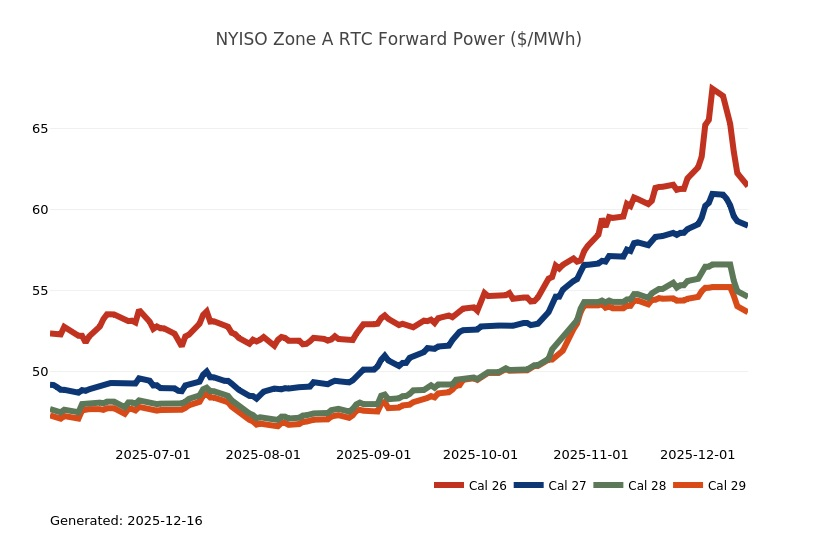
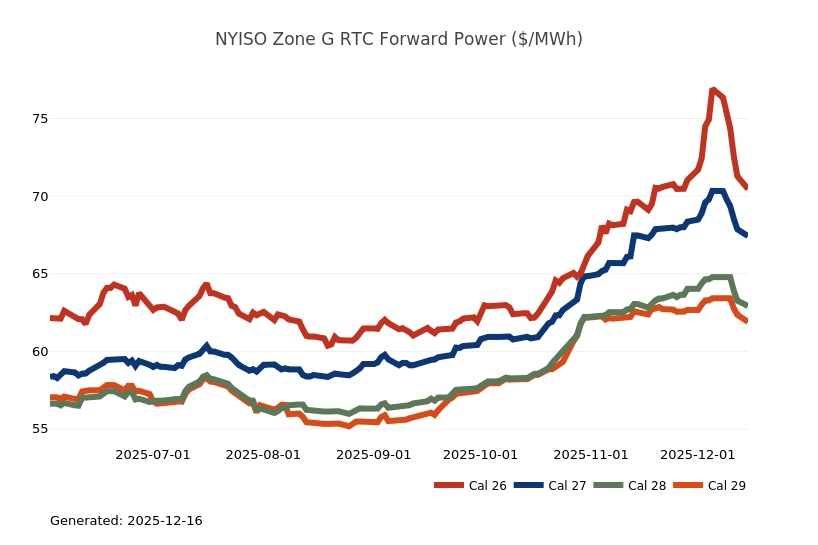

ERCOT Energy Summary



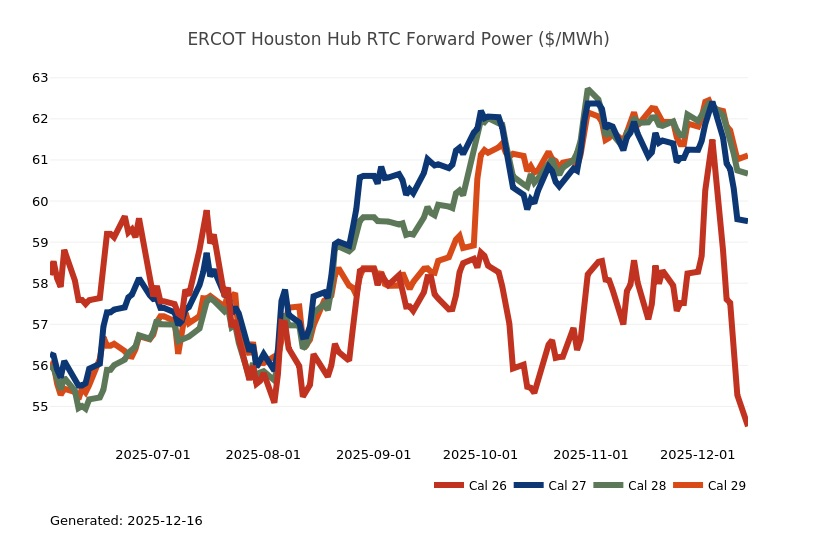
CAISO, Desert Southwest and Pacific Northwest Energy Summary
- Ski season is off to a rough start in the West. At the time we went to press, only 6% of trails in the state are open with most resorts showing closed or having only a token run open. Trends overnight on the forecasts looking towards the end of the year were again warmer across the Western U.S. making those Christmas ski trips to Park City or Tahoe look like a bust. The strongest above normal anomalies are focused far inland over the Rockies giving the map a blowtorch appearance of oranges and deep reds. While temperatures do appear to moderate closer to normal across the Pacific Norhtwest and along the immediate coast later next week and into the 11–15-day period, this is mostly precipitation-induced cooling as the storm track shifts farther south. That will bring one ingredient necessary to turn the ski season around, but the cold temperature side of that equation will be lacking. The storm track will remain very active into the Pacific Northwest through the remainder of the week with heavy rain at times along with notable mountain snow for higher elevations. With this active storm track will come with strong wind generation. A brief break is likely later this weekend into early next week before stronger generation is shown to return towards the Christmas holiday. Mostly clear skies are shown to be a common theme across Southern California through early next week before storminess will suppress solar gen late next week.
- As temperatures ease across the country, the outlook for gas out West is steadily improving as demand falls from the Midwest to the East Coast loosening up molecules to make their way west again. A ready supply of electrons on the grid coming out of Washington and Oregon is also serving to weaken the outlook for near term gas prices as recent/current rainfall is boosting hydro generation. PG&E has already called for high operational flow order (OFOs) for Wednesday and Thursday. The active storm track hitting the Pacific Northwest is also forcing the grid to try and absorb increasing amounts of wind generation as temperatures cut the demand. This bearish pressure is most evident in the power flows across the interties coming out the region with one line – the Pacific AC intertie – hitting an annual high yesterday as it averaged just over 2100 MWs across all twenty-four hours. Wind gen within the CAISO footprint will also increase and should bring the highest renewable output of the month at a flat 5,550 MWs tomorrow. Index buyers, this is your time.
- At the end of last week, snowpack outlooks remained on the low end of the scale with snow water equivalents showing 14% in Oregon and 8% in California. The next few waves of moisture should bring rain further south into Oregon and northern California, improving water supplies. At least the water supply outlook for The Dalles dam increased significantly to 102% of average for the April-September period (up from 91% the prior week) on the back of the recent storms. From a big picture perspective, this is important as it provides an off ramp for the region from potential shortfalls in supply. A recent reliability assessment from the consulting firm Energy + Environmental Economics (E3) warns of potential Pacific Northwest energy shortfalls as soon as next year. According to the E3 report, beginning in 2026, the region may face power shortages during extreme conditions, particularly in years with low hydropower output and prolonged cold snaps. The report states that while the projections are statistical and a blackout is unlikely within the next five years, they do coincide with “… rapid growth in energy demand, coal plant retirements, and insufficient replacement resources. Although new wind and solar projects have been added, they have not fully offset the reliability lost from fossil fuel retirements.” During adverse hydropower years combined with winter cold snaps, the projected reliability gap is approximately 1,300 megawatts in 2026, potentially increasing to 8,600 megawatts by 2030. While around 3,000 megawatts of new projects are expected by 2030, challenges remain due to drought, climate variability, and increased demand from population growth, electric vehicles and data centers. The forecasts for how fast electricity use will grow have only accelerated each year the PNW Utilities Conference Committee has analyzed the region. In 2022, the group estimated that energy demand would grow around 0.9% each year, with the summer and winter peak growing at a similar rate. Today, energy demand is expected to grow 3.2% a year.


Stay up-to-date on the latest energy news and information:
Coming soon from Constellation Customer Insights: Help us provide you with greater service by completing our online study later this month. For a limited time, eligible customers can choose to accept an incentive for taking the time to provide feedback.
- Energy Market Intel Webinar - Register for our next market update webinar on Wednesday, December 17 at 2 p.m. ET when the CMG team will provide insights on market factors currently affecting energy prices, such as weather, gas storage and production, and domestic and global economic conditions.
- Fortunato & Friends Webcast - Stay tuned for information regarding our next Fortunato & Friends webinar featuring Constellation's Chief Economist and a special guest
- Energy Terms to Know - Learn important power, gas and weather terms.
- Sustainability Assessment - We invite you to complete a brief assessment that helps us learn where your company is in building and/or implementing a sustainability plan. Through these insights, Constellation can customize solutions to meet your needs.
- Subscription Center - Sign up to receive updates on the latest market trends.
Questions? Please reach out to our Commodities Management Group at CMG@constellation.com.



